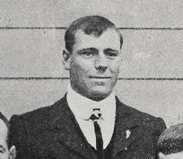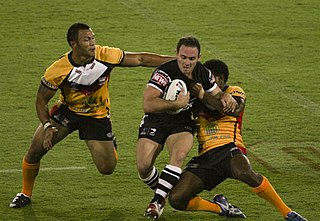
The 1907–1908 New Zealand rugby tour of Australia and Great Britain was made by a group of New Zealand rugby footballers who played matches in Australia, Ceylon, England and Wales between 1907 and 1908. Most of the matches were played under the rules of the Northern Union, a sport that is today known as rugby league. As such, the team were the immediate predecessors of the New Zealand national rugby league team. The tour had a large role in establishing rugby league in both Australia and New Zealand, and also gave birth to international rugby league. The tour party has come to be known as the professional All Blacks or All Golds, although at the time they were commonly referred to as the All Blacks—a named popularised by the New Zealand rugby union team that toured the Northern Hemisphere in 1905.
Hercules Richard "Bumper" Wright (1881–1963) was a New Zealand rugby footballer who was part of the professional 1907-1908 New Zealand rugby tour of Great Britain.

Tom "Angry" William Cross was a New Zealand rugby footballer who represented New Zealand in both rugby union and rugby league.
Conrad "Con" Augustus Byrne was a New Zealand rugby footballer who was part of the professional 1907-1908 New Zealand rugby tour of Great Britain.
Adam "Addie" Lile was a New Zealand rugby footballer who was part of the professional 1907-1908 New Zealand rugby tour of Great Britain.
James Barber was a New Zealand rugby footballer who represented New Zealand in rugby league.
The 1908 New Zealand rugby league season was the first season that rugby league had been played in New Zealand. Auckland played Wellington in a two match series that was won by Auckland 1-0. Otago and Southland also participated in a two match series which was drawn 1-all. Auckland and Taranaki then drew a two match series.
George Spencer (1878–1950) was a New Zealand rugby football player who represented New Zealand in both rugby union and rugby league. His brother, John, also was a dual-international.
John Clarence Spencer (1880–1936) was a New Zealand rugby football player who represented New Zealand in both rugby union and rugby league. His brother, George, also was a dual-international.
The 1909 New Zealand rugby league season was the second season of rugby league that had been played in New Zealand.
The 1912 New Zealand rugby league season was the fifth season of rugby league that had been played in New Zealand.
The 1913 New Zealand rugby league season was the sixth season of rugby league that had been played in New Zealand.
The 1960 New Zealand rugby league season was the 53rd season of rugby league that had been played in New Zealand.
The 1969 New Zealand rugby league season was the 62nd season of rugby league that had been played in New Zealand.
The 1971 New Zealand rugby league season was the 64th season of rugby league that had been played in New Zealand.
The 1977 New Zealand rugby league season was the 70th season of rugby league that had been played in New Zealand.
The 1980 New Zealand rugby league season was the 73rd season of rugby league that had been played in New Zealand.
Arthur Carlaw was a New Zealand rugby league player who played a role in the establishment of the sport in New Zealand and represented New Zealand.




